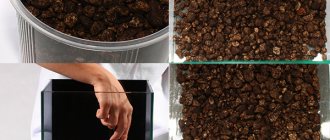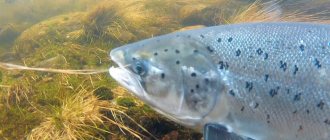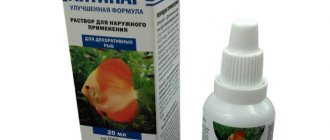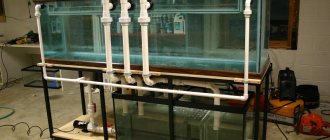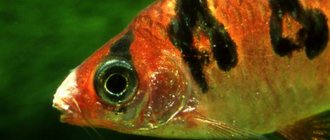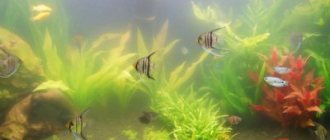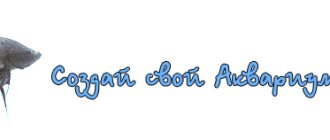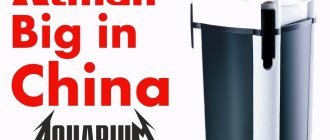Plants and mosses
Meristem aquarium plants or In Vitro - WHAT IS IT?
The basis for the production of such plants is the laboratory of clonal micropropagation of plants. This is a specialized complex of premises and equipment in which mass propagation of plants occurs in isolated, sterile conditions. Such breeding conditions have a name - in vitro conditions (literally from the Latin “in glass”).
Plants in vitro are grown in a specially prepared nutrient medium, which is selected depending on the necessary requirements of the aquarium plant. Planting meristem plants (In Vitro) is carried out according to the same principle as in the case of plants grown in water. The only difference is that before planting, you need to rinse the nutrient gel under a small stream of water from a tap or in some container.
Plants grown in this way have a number of advantages:
No snails or algae. Probably, many aquarists have encountered a situation where, some time after purchasing and planting new plants, snails and/or algae appear in the aquarium. Since meristem plants are grown in sterile conditions, there is no danger of introducing algae spores or snails.
No fungi or infections. Aquarium plants, like all living organisms on the planet, are susceptible to a number of diseases, but unlike animals, they do not develop immunity. During laboratory propagation there is no danger of fungi and infections being introduced into the aquarium. Healthy plants are the key to a successful aquarium launch.
Uniformity of plants. This may not be such a big problem for many aquarists, but if you think about it, meristy plants are a 100% guarantee of planting exactly the plant you purchased.
Compact packaging and easy delivery and storage. Thanks to the small size of the packaging, it is convenient to transport and deliver aquarium plants over long distances. Perhaps many aquarists have encountered a problem: they bought plants, but there is nowhere to plant them yet. With “In Vitro” everything is simpler - they can be stored for about a month before planting, simply left on the windowsill or near the aquarium, and at room temperature, of course.
Price. In one serving you get quite a large number of small plants.
For planting meristem plants in vitro, it is recommended to use tweezers. You can also purchase it in our online store.
PACKAGING AND DELIVERY OF LIVE PLANTS
Plants are packaged in sealed packages that protect them from mechanical damage and moisture loss. The packaging contains a label that contains the name of the plant and a brief description (type, maintenance conditions, recommended planting location in the aquarium. All plants are stored and collected for shipment in an air-conditioned room, which guarantees maximum freshness and quality of the plants.
Parcels with plants are always carefully prepared taking into account weather conditions. During frosts and heat, we use additional isothermal means to protect seedlings from sudden temperature changes and excessive heat or overheating. Regardless of weather conditions, plants are always sent in hard cardboard packaging.
Aquarium plants are sent by the transport company SDEK and Russian Post 1st class.
Aquaria2.RU
In the second issue of “RiR” for this year, an article by A. Roor “The Dutch Aquarium” was published. Beautiful, unique exhibitions of the underwater world of freshwater tropical reservoirs of distant countries and continents - isn’t this the dream of many aquarists!
As can be seen from the article and other published materials, including translations, which in no small part pass through the hands of amateurs, as well as from advertising books specifically dedicated to the exhibitions of the Dutch aquarium, its main feature is the extreme saturation of plants in the water column, at which there is no free space on the ground and the back and side walls of the aquarium are not visible. The plants chosen are the most accessible, easy and fast growing, and apparently very cheap, which makes it possible to use dozens of specimens of the same species to create group thickets. In the aquarium, they are placed in accordance with the structural and color features so as to create smooth transitions from one group of plants to others that are pleasing to the eye. The vast majority of plants are long-stemmed.
Three years ago, at a meeting of aquarists in Poland, Dutch hobbyists demonstrated the creation of an aquarium display right in front of those present. All that remained was to launch the fish and turn on all the modern life support equipment - and the Dutch aquarium was ready.
Who first came up with it and when is unknown. But why did this type of decorative aquarium arise in Holland? The fact is that this is a country of excellent flower growers and plant growers; It is also well known for its traditions in the field of research of aquarium plants, including rare and rare ones.
It seems to me that the reasons for the popularity and wide distribution of the Dutch-type decorative aquarium are as follows. Firstly, the availability for sale in a large selection of fast-growing and rapidly reproducing plants, as well as the necessary aquariums and all the equipment for them. Secondly, the speed of its installation: gave the order, paid, delivered, collected, filled with water, placed plants and fish, turned on the equipment.
I foresee the objections of our aquarists: “Suppose we create the equipment too. Let's find and grow plenty of simple, fast-growing plants. We can quickly plant them in bunches. Well, what about, for example, cryptocorias, echinodoruses or aponogetons? You can’t just plant them in the ground. And it’s not easy to grow a sometimes rare, difficult to grow, slow-growing plant into the ground.”
The answer is simple: no way. As a rule, such plants, which are especially popular here, are not found in the Dutch aquarium. And only in exceptional cases can they be seen in “strong” points of the aquarium. And I don’t think they can be planted in 10 minutes.
The decorative aquarium of the Dutch type may also find popularity among our hobbyists. But now he does not belong to the main place.
Our country has long developed another, its own, no less attractive and beautiful, but not so “fast” type of decorative aquarium. Most of these aquariums were probably created in Moscow. Therefore, it can rightfully be called a Moscow decorative aquarium.
Moscow has always been the center of our aquarium industry. There are a lot of highly qualified aquarists here. All lovers know the Moscow Bird Market, where, apparently, most of the newly imported fish and plants end up. Therefore, it is in Moscow that most often it is possible to obtain, study, acclimatize, breed, and introduce new fish and new plants into culture. In addition, the technical base of amateur aquarium hobby is well developed here.
More and more new plants came into culture and fashion. Plants that were quickly and easily grown became widespread and after some time went out of fashion. And in return, new rare “difficult” plants appeared. Difficult to breed or maintain (and therefore not very common), they settled in amateur aquariums for many years, often in large collections, reached adulthood and were especially carefully protected. As the number of imported species of valuable plants became more and more numerous, their number in amateur aquariums also increased. Sometimes there was not a decimeter of free space left in the reservoirs, not counting the “clearing” for feeding the fish. Often new aquariums were built for plants - wide, deep, high. And now the underwater jungle has obscured the rear and side walls. Then the plants began to be arranged in terraces: small specimens, so that they would not get lost, were planted in the foreground (G.I. Kretov) or on a special terrace - “shallow coastal zone” - in the background (V.S. Komarov). This is how the type of Moscow decorative aquarium developed. Its distinctive features are as follows.
1. Since the main object of the aquarium was not exotic fish, but aquatic plants, the size of the aquarium, its equipment (including lighting) and even the species and quantitative composition of fish were subordinated to the decorative exhibition, mainly the collection of plants.
2. As for the selection of plants, they are usually short-stemmed. “Rosettes” are very popular - not the first ones that come to hand, but selected taking into account their characteristics and decorative value. Plants are mature, well developed, always healthy, often grown from a small shoot to maximum size in a free, allocated place; single specimens are large, groups are small and medium-sized plants. Mandatory condition: the reservoir should contain only problematic, rare, and difficult to breed species. Since there are many cultivated plants, each aquarium is unique in terms of the set of plants, their age, and location.
3. The aquarium should have a high planting density. It is also created by the splendor of well-developed plants (many echinodorus, aponogetons, and nymphs are multi-leaved to such an extent that it is impossible to see either other plants or the walls of the aquarium behind them). Since amateurs try to plant more different plants, the aquarium is not inferior to the Dutch aquarium in terms of the density of green mass. Neither the side nor the back walls are usually visible.
4. Small spaces of soil free from plants are needed - small “clearings” that are left for fish and for decorative purposes.
It is customary for us to consider part of the correctly selected soil an interesting decorative element. You can often see driftwood or a beautiful stone in an aquarium. Apparently, the attachment of a resident of a forest belt to a clearing with forbs, surrounded by trees and bushes, sometimes with an old stump, a fallen tree, or a boulder, is reflected.
5. The Moscow decorative aquarium involves the simultaneous maintenance of plants belonging to different families, ecological and geographical regions.
6. In contrast to the Dutch type aquarium, which mainly has long-stemmed plants that quickly grow in length, in the Moscow aquarium, as noted above, mainly short-stemmed plants are used - cryptocorynes, echinodorus, aponogetons, anubias. In them, only the growth of leaves is visually noted, but the stem seems to remain unchanged. Gradually the bushes become more luxuriant and increase in width and diameter.
7. Apparently, tiering is a feature of any type of decorative aquarium. Logic tells the aquarist to plant small plants in the foreground - in groups or single specimens (it is difficult to say what grows best and when and looks more decorative - it depends on specific conditions). The largest plants are placed in the background. Typically, a wide aquarium has 3–4 tiers. The so-called soil slides look very good. I.M. Komkov makes them up to 25 cm high, changing the landscape of the bottom along the width of the aquarium. The ground level along the length of the aquarium is also not the same. The lowest place is located at the front glass, somewhat to the side. At higher elevations, groups of cryptocorynes, small anubias and echinodorus grow better and look more decorative.
These are the basic principles of building an exhibition. Obviously, such an aquarium cannot be set up quickly. It takes six months, or even a year, to select, grow and develop plants.
Maintenance of the Moscow aquarium is low. It comes down to feeding the fish and monitoring their health. Plants need to remove old leaves, replace or plant new bushes. Of course, the exhibition gradually changes, especially in the first time after its creation.
And now about some technical features of the Moscow aquarium. In size it can be from 150 to 500 - 600 liters. But even a relatively small aquarium can be extremely decorative and bright. An example of this were the aquariums of G.I. Kretov, which were distinguished by a rare set and combination of plants that were always in excellent condition. In different years, V.A. Tolbaev, A.A. Androshchuk, O.T. Egorov, V.P. Larionov, E.K. Bragin, V.S. Zhdanov, V.S. .Komarov, Yu.N. Leonov and many others.
The soil is almost always pebbles (4-8mm) or granite crushed stone. Placing peat, humus, silt, and turf under the ground is not practiced. The water is aerated. Hanging filters are often used. Stirring the water, perfect lighting, and regular partial water changes are necessary.
Thus, the technical equipment of an aquarium is not difficult. As for its size, it must be consistent with the size of the selected plants.
The intensity and duration of lighting in a Moscow aquarium varies significantly depending on the specific set and age of plants. But in general, the required power is determined at the rate of 0.5 - 1 W per 1 liter of water. Depending on the size and depth of the aquarium, lamps are chosen, mainly LB, LF tubes, often U-shaped. Daylight hours are 10–13 hours (again, depending on the intensity of the lighting system and the specific set of plants, their age, the location of the aquarium in the room, etc.). In a large aquarium, in different parts of it, lighting of different power is often used.
There are very few requirements for fish for a Moscow decorative aquarium: they should not eat, break or tear plants out of the ground. With a large number of plants, it is advisable to keep more fish, which provides good conditions for feeding the plants.
As an example, we give a description of a decorative aquarium created by V.P. Larionov (its general appearance and individual fragments are shown on the third page of the cover).
Aquarium length – 140, width – 50, height – 46 cm. The planting diagram is shown below. As can be seen from the diagram, despite observing the principle of tiers in the placement of plants (small ones - near the front glass, larger ones - in the second, third plan, etc.), they are located quite complexly. Plants are not the same in height, area occupied, and bush shape, so placing them along three to five lines is not always possible. They are located freely, like trees in a forest, and occupy the space everyone needs.
In the described aquarium, planting is conventionally carried out along four horizontal stripes. Planting locations are also indicated approximately. The Moscow Aquarium does not have the main objects - the so-called “strong points” of the exhibition. Despite this, certain plants may attract the attention of a particular observer more than all others. The peculiarity of the Moscow aquarium is that every section of it is a reserve of healthy, beautiful, well-groomed plants. And it seems that nothing can be replaced, much less removed.
The Moscow Decorative Aquarium is accessible to every patient aquarist, and I hope that it will find many new admirers. It is possible that someone will want to share their findings and send photographs of decorative displays for publication in the magazine. Perhaps hobbyists from other cities will talk about their decorative aquariums.
In conclusion, I provide a list of plants that, in my opinion, are advisable to use for a decorative aquarium of the described type. The list does not include all plants used in decorative aquariums. Thus, there are no long-stemmed plants, which are the basis of a Dutch-type aquarium. In a Moscow-type aquarium, long-stemmed plants, as a rule, do not carry an independent load and are used more often as an auxiliary element to fill empty areas, mainly in the background and along the edges.
Plants recommended for the Moscow decorative aquarium
| Plant type | Plan |
| ANUBIAS | |
| A. barteri var. nana A. gilletli A. heterophylia A. hastifolia A. barteri var. anguslifolia A. afzellii | front middle middle and rear rear |
| ECHINODORUS | |
| E. africanus E. horemanii E. intermedius E. horizontalis E. berteroi E. cordifolius E. scaber E. "tunicatus" E. macrophyllus E. inpai E. "muricatus" E. schlueteri E. aschersonianus E. "trialatus" E. opacus E. major E. parviflorus E. argentinensis E. floribundus E. pellucidus E. andrieuxii E. “sellovianus” E. polaeifolius var. latifolia E. bleheri E. osiris E. paniculatus Echinodorus of the Tenellii group | middle and back middle and back middle middle middle and back middle middle middle middle middle middle front middle middle middle middle and back middle middle middle middle middle middle and back back middle and back middle front |
| APONOGETONES | |
| A. rigidifolius A. "ledder" A. crispus A. ulvaceus A. spec. rot | rear middle and rear middle middle middle |
| CRYPTOCORYNES | |
| C. usteriana C. balansae C. spiralii C. retrospiralis C. ciliata var. ciliata C. ciliata var. latifolia C. becketii Section Cordatae C. parva C. nevilli C. lucens C. wendtii var. wendtil C. wendtii var. jahnellii C. wendtii var. "lutea" C. wendtii var. nana C. wendtii var. rubela C. wendtii var. crauteri C. walkeri var. legroi C. walkeri var. walkeri C. walkeri var. lutea C. axelrodi C. petchii C. pontederiifolia | back middle and back middle middle middle back front and middle middle front front front middle middle and back middle front front front front and middle front front front and middle front middle |
Planting scheme
| 1 | 2 | 3 | 4 | 5a | 6b | 7a | 8 | |
| 5 B | 6a | 76 | ||||||
| 9b | 10 | 11b | 12 | 13 | 14b | 15 | 16 | |
| 9a | 11a | 14a | ||||||
| 17 | 18 | 20a | 21a | 22 | 23 | 24 | 25 | |
| 19 | 20b | 21b | ||||||
| 26 | 27 | 28 | 29 | 30 | 31 | 32 | ||
1 – Aponogetone rigidifolus; 2 – Hygrophyla stricta; 3 – Miriophyllum brasiliensis; 4 – Rotala indica; 5a – Microsorium pteropus; 5b – Echinodorus intermedius; 6a – Alternantera Iilacina; 6b – Hottonia inflata; 7a – Valitsneria spiralis; 7b – Vesicularia dubyana; 8 – Nymphea “tiger lotos”, red form; 9a – Cryptocoryne wendtii var. janelli; 9b – Cryptocoryne siamensis var. Kerry; 10 – Echinodorus portoalegrensis; 11a – Cryptocoryne balansae; 11b – Anubias congensis; 12 – Bacopa monieri; 13 – Nuphar luteum; 14a – Aponogetone “lucens”; 14b – Lybwigia arcuata; 15 – Cryptocoryne usterlana; 16 – Cryptocoryne retrospiralis; 17 – Echinodorus schlueteri; 18 – Rotala macrandra; 19 – Echinodorus schlueteri; 20a – Peplis diandra; 20b – Anubas barteri var. dad; 21a – Ammania senegalensis; 21b – Echinodorus marajoensis; 22 – Cryptocoryne nevilli and Cryptocoryne petchii; 23 – Cryptocoryne axelrodi and Cryptocoryne walkeri var. legroi; 24 – Alternantera rosaelfolia; 25 – Echinodorus “brasiliensis”; 26 – Cryptocoryne wendtll var. dad; 27 – Cryptocoryne wendtii var. rubela; 28 – Cryptocoryne walkeri var. lutea; 29 – Cryptocoryne walkeri var. walkeri; 30 – free space; 31 – Cryptocoryne walkeri var. walkeri; 32 – Echinodorus tenetlus.

